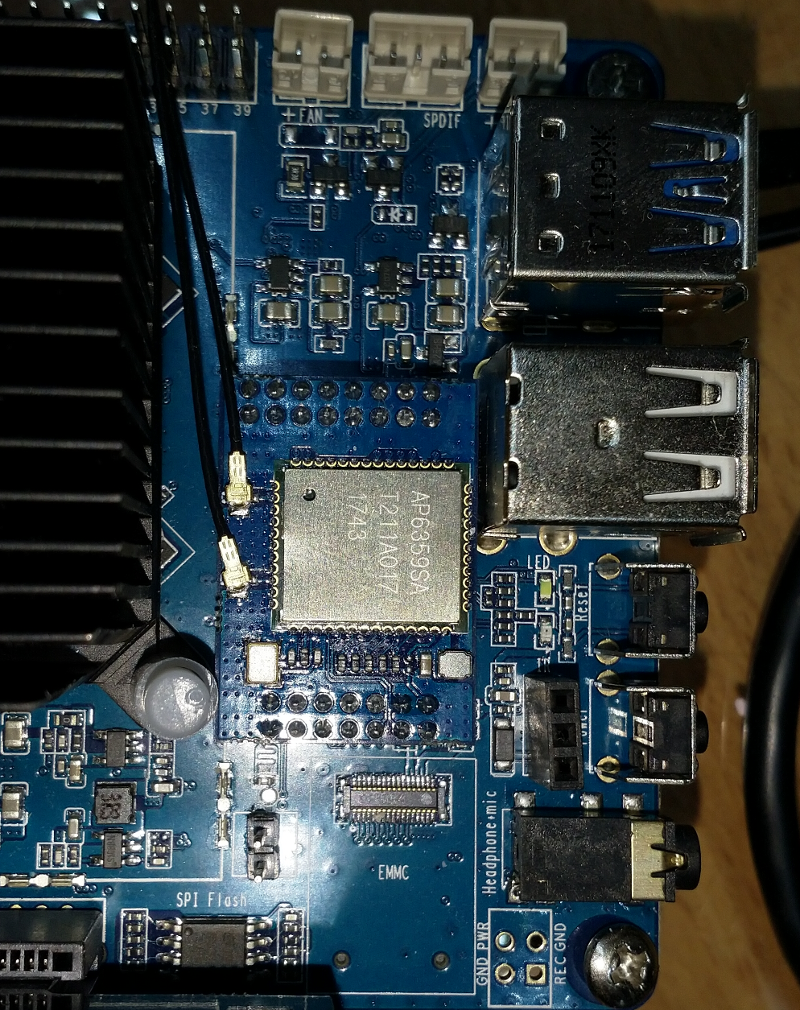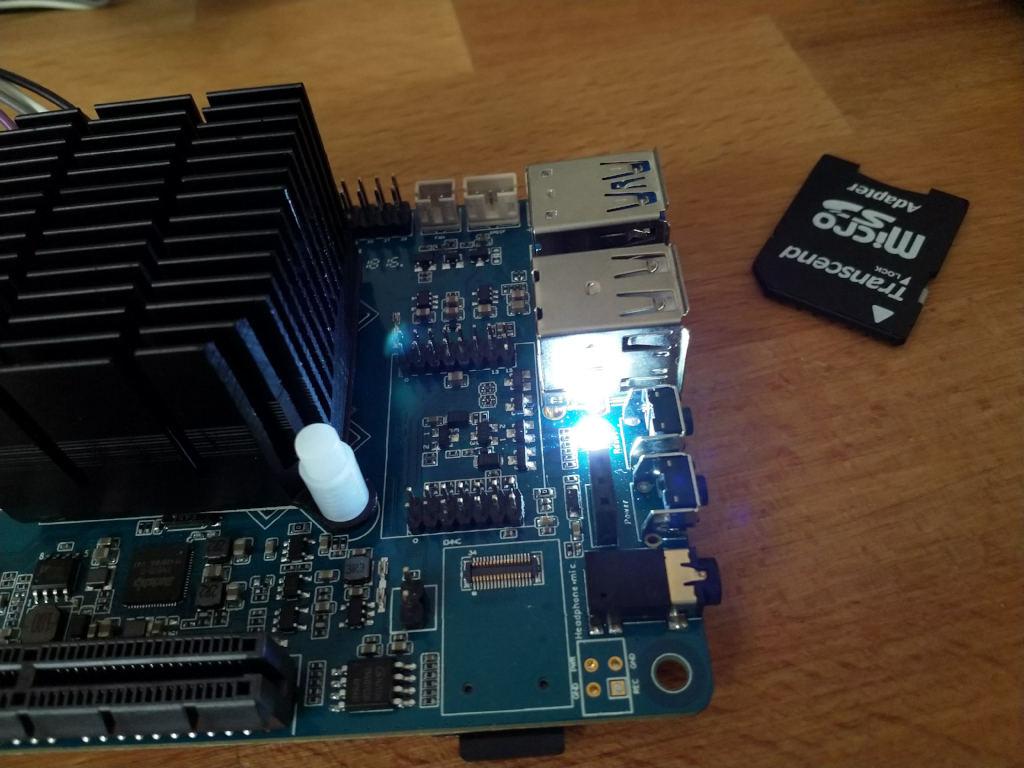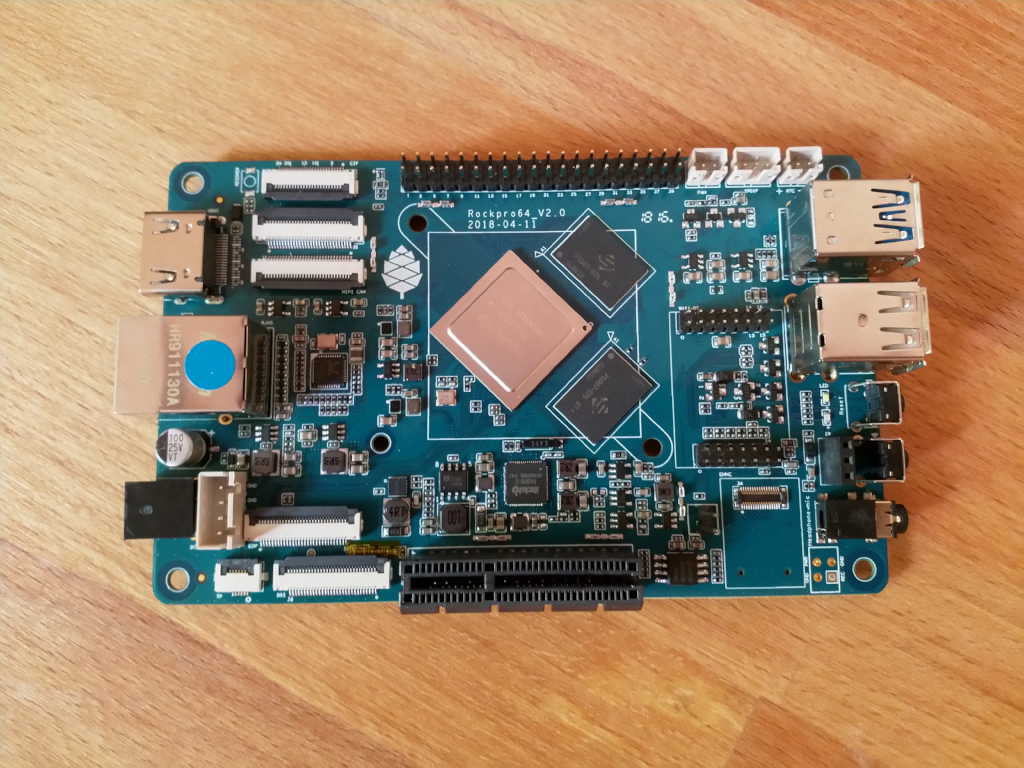ROCKPro64 - Das erste Mal
-
Heute habe ich mich nochmal an das Thema WLan auf dem ROCKPro64 gemacht. Mr.Fixit hat ja versprochen, das mit seinem Image WLan möglich wäre.
Releases · mrfixit2001/debian_builds
Minimal 2-partition debian builds with minimal customizations - Releases · mrfixit2001/debian_builds
GitHub (github.com)
Das Modul was Pine64 verkauft. Dieses Modul wird auf den entsprechenden Steckplatz montiert.

Das Image von Mr. Fixit benutzt folgende Daten zum Einloggen.
User: rock PW: rockAls Hostname ist localhost gesetzt, was in meiner IPFire nicht korrekt angezeigt wird, so das ich den erst mal in /etc/hostname geändert habe. Erleichtert mir das Finden der entsprechenden IP-Adresse.
Folgender Kernel wird benutzt.
rock@localhost:~$ uname -a Linux localhost 4.4.169 #3 SMP Thu Jan 10 20:05:09 EST 2019 aarch64 GNU/LinuxBeim Image von Mr. Fixit wird die uart-Ausgabe auf einen HDMI-Monitor umgeleitet. Mag ich gar nicht, kann man schlecht bugfixen, wenn die ganzen Ausgaben nicht im uart erscheinen. Muss man irgendwo ändern können!? Aber erst mal nicht wichtig!
Status
rock@rp64_debian_mr:~$ ip a 1: lo: <LOOPBACK,UP,LOWER_UP> mtu 65536 qdisc noqueue state UNKNOWN group default qlen 1 link/loopback 00:00:00:00:00:00 brd 00:00:00:00:00:00 inet 127.0.0.1/8 scope host lo valid_lft forever preferred_lft forever inet6 ::1/128 scope host valid_lft forever preferred_lft forever 2: eth0: <BROADCAST,MULTICAST,UP,LOWER_UP> mtu 1500 qdisc pfifo_fast state UNKNOWN group default qlen 1000 link/ether 62:03:b0:d6:dc:b3 brd ff:ff:ff:ff:ff:ff inet 192.168.3.12/24 brd 192.168.3.255 scope global eth0 valid_lft forever preferred_lft forever inet6 fe80::ee04:6118:e916:2f8/64 scope link valid_lft forever preferred_lft forever 3: wlan0: <BROADCAST,MULTICAST,UP,LOWER_UP> mtu 1500 qdisc pfifo_fast state UNKNOWN group default qlen 1000 link/ether ac:83:f3:e6:1f:b2 brd ff:ff:ff:ff:ff:ff inet 169.254.170.236/16 brd 169.254.255.255 scope global wlan0 valid_lft forever preferred_lft forever inet6 fe80::c071:83df:6e42:d07c/64 scope link valid_lft forever preferred_lft foreverKarte
root@rp64_debian_mr:/home/rock# iw dev phy#0 Interface wlan0 ifindex 3 wdev 0x1 addr ac:83:f3:e6:1f:b2 type managed txpower 31.00 dBmiwconfig
root@rp64_debian_mr:/home/rock# iwconfig lo no wireless extensions. wlan0 IEEE 802.11 ESSID:"" Mode:Master Frequency:5.18 GHz Access Point: Not-Associated Bit Rate:433 Mb/s Tx-Power:32 dBm Retry min limit:7 RTS thr:off Fragment thr:off Encryption key:off Power Managementmode:All packets received Link Quality=5/5 Signal level=-2 dBm Noise level=-41 dBm Rx invalid nwid:0 Rx invalid crypt:0 Rx invalid frag:0 Tx excessive retries:0 Invalid misc:0 Missed beacon:0 eth0 no wireless extensions.WLan Verbindung herstellen
Damit wir uns mit dem WLan verbinden können, brauchen wir eine Konfigurationsdatei /etc/wpa_supplicant.conf
ctrl_interface=/var/run/wpa_supplicant ctrl_interface_group=rock # Die Gruppe muss natuerlich angepasst werden eapol_version=1 # 0: Der Treiber des Interfaces k mmert sich um das Scannen von Netzen und die AP-Auswahl. # Dieser Modus sollte benutzt werden, wenn man eine Verschl sselung auf ein Kabelnetzwerk $ # 1: wpa_supplicant k mmert sich um das Scannen von Netzen und die AP-Auswahl. # 2: Fast wie 0, es wird aber mit Hilfe von Sicherheitsrichtlinien und der SSID zu APs verbund$ # # Normalerweise funktioniert entweder Modus 1 oder Modus 2. ap_scan=1 network={ ssid="SSID" scan_ssid=1 proto=RSN key_mgmt=WPA-PSK pairwise=CCMP group=CCMP psk="password" }Danach mit dem WLan verbinden
wpa_supplicant -B -i wlan0 -c /etc/wpa_supplicant.conf Successfully initialized wpa_supplicantBei dem Image vom Kamil passiert mir immer folgendes
rock64@rockpro64:~$ sudo wpa_supplicant -B -i wlan0 -c /etc/wpa_supplicant/wpa_supplicant.conf [sudo] password for rock64: Successfully initialized wpa_supplicant ctrl_iface exists and seems to be in use - cannot override it Delete '/var/run/wpa_supplicant/wlan0' manually if it is not used anymore Failed to initialize control interface '/var/run/wpa_supplicant'. You may have another wpa_supplicant process already running or the file was left by an unclean termination of wpa_supplicant in which case you will need to manually remove this file before starting wpa_supplicant again. nl80211: deinit ifname=wlan0 disabled_11b_rates=0Ok, Prozeß suchen und killen.
rock64@rockpro64:~$ htop rock64@rockpro64:~$ sudo kill 504 rock64@rockpro64:~$ kill 504 -bash: kill: (504) - No such processUnd erneut verbinden
rock64@rockpro64:~$ sudo wpa_supplicant -B -i wlan0 -c /etc/wpa_supplicant/wpa_supplicant.conf Successfully initialized wpa_supplicantKurz warten, danach sieht man folgendes
rock@rp64_debian_mr:~$ ip a 1: lo: <LOOPBACK,UP,LOWER_UP> mtu 65536 qdisc noqueue state UNKNOWN group default qlen 1 link/loopback 00:00:00:00:00:00 brd 00:00:00:00:00:00 inet 127.0.0.1/8 scope host lo valid_lft forever preferred_lft forever inet6 ::1/128 scope host valid_lft forever preferred_lft forever 2: eth0: <NO-CARRIER,BROADCAST,MULTICAST,UP> mtu 1500 qdisc pfifo_fast state DOWN group default qlen 1000 link/ether 62:03:b0:d6:dc:b3 brd ff:ff:ff:ff:ff:ff 3: wlan0: <BROADCAST,MULTICAST,UP,LOWER_UP> mtu 1500 qdisc pfifo_fast state UP group default qlen 1000 link/ether ac:83:f3:e6:1f:b2 brd ff:ff:ff:ff:ff:ff inet 192.168.178.25/24 brd 192.168.178.255 scope global wlan0 valid_lft forever preferred_lft forever inet6 2a02:908:126b:5620:754a:6ec0:3e78:9035/64 scope global mngtmpaddr noprefixroute dynamic valid_lft 7162sec preferred_lft 3562sec inet6 fe80::e27b:e3f7:18b8:bb95/64 scope link valid_lft forever preferred_lft foreverGut, wir haben eine IP-Adresse. YEAH!

Sollte das mit der IP-Adresse nicht funktionieren, kann man das hiermit nochmal anstoßen.
sudo dhclient wlan0Netzwerkkabel entfernen! Einloggen über die WLan-Adresse.
frank@frank-MS-7A34:~$ ssh rock@192.168.178.25 rock@192.168.178.25's password: Linux rp64_debian_mr 4.4.169 #3 SMP Thu Jan 10 20:05:09 EST 2019 aarch64 The programs included with the Debian GNU/Linux system are free software; the exact distribution terms for each program are described in the individual files in /usr/share/doc/*/copyright. Debian GNU/Linux comes with ABSOLUTELY NO WARRANTY, to the extent permitted by applicable law. Last login: Sat Feb 16 10:34:46 2019 from 192.168.3.213Läuft. Das erste Mal das ich auf dem ROCKPro64 funktionierendes WLan sehe!
Was mich natürlich auch noch interessiert hat ist, ob WLan und PCIe zusammen funktioniert. Das kann ich leider nicht bestätigen, meine PCIe NVMe SSD wird nicht erkannt.
Schade, ich habe mal einen Fehlerbericht erstellt.
Damit ist leider die Frage immer noch unbeantwortet ob WLan und PCIe zusammen nutzbar ist!!
-
Vielen Dank fürs Testen.
Ich nehme an Du hast das Pine64 Wifi Modul getestet.Momentan sind die Geschwindigkeiten ja noch recht mau, oder?
Welche theoretische Geschwindigkeit und Kanalbreite wurde denn zwischen Router und RP64 ausgehandelt?Viele Grüße,
Florian -
Die Fritzbox zeigt die üblichen Phantasiewerte an, die man in der WLan Branche gut zum Verkaufen nutzen kann.
780 / 292 Mbits/s (Datenrate in Richtung WLan-Gerät / in Richtung Fritzbox)
Ok, ich bin kein WLan-Experte, die Werte sehen echt mau aus. (Richtiger Treiber?)
Das Pine64-Modul wurde benutzt. https://forum.frank-mankel.org/topic/190/rockpro-wlan-modul
Die Info bzgl. Modul in ersten Post ergänzt.
-
Heute Morgen kam mir die Idee, so schlecht wie oben beschrieben, kann das WLan-Modul ja eigentlich nicht sein.
Also, neuer Test. Diesmal nur per wget was ziehen und den Taschenrechner nehmen

Test 1 ( 60 Mbit/s)
Von der IPFire Seite das ISO Image x86_64 runtergeladen.
Test 2 (60 Mbit/s)
Von der LinuxMint Seite das Cinnamon Image runtergeladen (FH Aachen)
Test 3 (100 Mbit/s)
Von der LinuxMint Seite das Cinnamon Image runtergeladen (FH Aachen)
Auswertung
Test Nr. Datei Größe Zeit Downloadgeschwindigkeit 1 IPFire ISO Image 254 MB 64s 3,97 MB/s 2 LinuxMint Cinnamon Image 1,83 GB 240s 7,84 MB/s 3 LinuxMint Cinnamon Image 1,83 GB 161s 11,69 MB/s Fazit
So sieht das ja schon wesentlich besser aus. Der IPFire Download-Server wird eine Bandbreitenbeschränkung haben, von der FH Aachen geht es dann wesentlich flotter. Das entspricht meinem derzeitigen Downloadspeed am Anschluß.

Da zufälligerweise heute mein Anschluss auf 100 Mbit/s umgestellt wurde, habe ich den Test Nr. 3 nochmal wiederholt. Auch hier ist die Leitung wieder am Limit.

Den oben gemachten iperf3 Test werde ich dann löschen, der ist Müll.
-
Ich kann heute die Fragen aller Fragen beantworten

Damit ist leider die Frage immer noch unbeantwortet ob WLan und PCIe zusammen nutzbar ist!!
Es geht!!
Ich habe von MrFixit ein Testimage der RecalBox, benutzt das selbe Debian wie oben. Die Tage konnte man im IRC verfolgen, wie man dem Grundproblem näher kam und wohl einen Fix gebastelt hat, damit beides zusammen funktioniert. Mr.Fixit hat das in RecalBox eingebaut und ich durfte testen.
# ip a 1: lo: <LOOPBACK,UP,LOWER_UP> mtu 65536 qdisc noqueue qlen 1 link/loopback 00:00:00:00:00:00 brd 00:00:00:00:00:00 inet 127.0.0.1/8 scope host lo valid_lft forever preferred_lft forever inet6 ::1/128 scope host valid_lft forever preferred_lft forever 2: eth0: <NO-CARRIER,BROADCAST,MULTICAST,UP8000> mtu 1500 qdisc pfifo_fast qlen 1000 link/ether 62:03:b0:d6:dc:b3 brd ff:ff:ff:ff:ff:ff 3: wlan0: <BROADCAST,MULTICAST,UP,LOWER_UP8000> mtu 1500 qdisc pfifo_fast qlen 1000 link/ether ac:83:f3:e6:1f:b2 brd ff:ff:ff:ff:ff:ff inet 192.168.178.27/24 brd 192.168.178.255 scope global wlan0 valid_lft forever preferred_lft forever inet6 2a02:908:1262:4680:ae83:f3ff:fee6:1fb2/64 scope global dynamic valid_lft 7145sec preferred_lft 3545sec inet6 fe80::ae83:f3ff:fee6:1fb2/64 scope link valid_lft forever preferred_lft forever # ls /mnt bin etc media recalbox sd.img test2.img boot home mnt root selinux tmp crypthome lib opt run srv usr dev lost+found proc sbin sys var # fdisk BusyBox v1.27.2 (2019-02-01 22:43:19 EST) multi-call binary. Usage: fdisk [-ul] [-C CYLINDERS] [-H HEADS] [-S SECTORS] [-b SSZ] DISK Change partition table -u Start and End are in sectors (instead of cylinders) -l Show partition table for each DISK, then exit -b 2048 (for certain MO disks) use 2048-byte sectors -C CYLINDERS Set number of cylinders/heads/sectors -H HEADS Typically 255 -S SECTORS Typically 63 # fdisk -l Disk /dev/mmcblk0: 15 GB, 15931539456 bytes, 31116288 sectors 486192 cylinders, 4 heads, 16 sectors/track Units: cylinders of 64 * 512 = 32768 bytes Device Boot StartCHS EndCHS StartLBA EndLBA Sectors Size Id Type /dev/mmcblk0p1 * 2,10,9 10,50,40 32768 163839 131072 64.0M c Win95 FAT32 (LBA) Partition 1 does not end on cylinder boundary /dev/mmcblk0p2 * 16,81,2 277,102,17 262144 4456447 4194304 2048M 83 Linux Partition 2 does not end on cylinder boundary /dev/mmcblk0p3 277,102,18 1023,254,63 4456448 31115263 26658816 12.7G 83 Linux Partition 3 does not end on cylinder boundary Disk /dev/nvme0n1: 233 GB, 250059350016 bytes, 488397168 sectors 2543735 cylinders, 12 heads, 16 sectors/track Units: cylinders of 192 * 512 = 98304 bytes Device Boot StartCHS EndCHS StartLBA EndLBA Sectors Size Id Type /dev/nvme0n1p1 1,0,1 907,11,16 2048 488397167 488395120 232G 83 Linux #Oben sieht man eine funktionierende WLan-Verbindung, das LAN-Kabel war entfernt. Unten sieht man die PCIe NVMe SSD, gemountet nach /mnt und Inhaltsausgabe.
Das sollte beweisen, das der Ansatz der Lösung funktioniert. Leider kann ich nicht sagen, das es zum jetzigen Zeitpunkt stabil läuft. Ich habe einfach so Reboots, kann den Fehler aktuell aber nicht fangen. Mal sehen ob ich noch was finde.
Aber, es ist ein Anfang!


